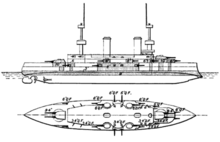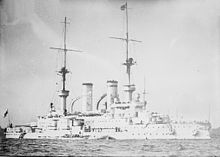SMS Wittelsbach
After the start of World War I in August 1914, Wittelsbach was brought back to active duty in IV Battle Squadron.
The ship served in the Baltic Sea, including during the Battle of the Gulf of Riga in August 1915, but saw no combat with Russian forces.
By late 1915, crew shortages and the threat from British submarines forced the Kaiserliche Marine to withdraw older battleships like Wittelsbach.
In June 1897, Hollmann was replaced by Konteradmiral (KAdm—Rear Admiral) Alfred von Tirpitz, who quickly proposed and secured approval for the first Naval Law in early 1898.
[4] Unlike her sister ships, Wittelsbach was completed with provisions for a squadron commander's staff, including a larger bridge.
Wittelsbach's powerplant was rated at 14,000 metric horsepower (13,808 ihp; 10,297 kW), which generated a top speed of 18 knots (33 km/h; 21 mph).
[4] Wittelsbach's keel was laid down on 30 September 1899 at the Kaiserliche Werft (Imperial Shipyard) in Wilhelmshaven, listed under construction number 25.
Completion of the ship was delayed due to a collision with the ironclad Baden, which accidentally rammed Wittelsbach in July 1902 while she was fitting out.
After trials ended, Wittelsbach was transferred from Wilhelmshaven to Kiel in the Baltic Sea, but she ran aground in the Great Belt in heavy fog on 13 December.
During its cruise in the North Sea, the fleet experimented with wireless telegraphy on a large scale and searchlights at night for communication and recognition signals.
The fleet moved to the North Sea on 3 September, where it took part in a major landing operation, after which the ships took the ground troops from IX Corps who had participated in the exercises to Altona for a parade for Wilhelm II.
The summer cruise ended on 9 August, though the autumn maneuvers that would normally have begun shortly thereafter were delayed by a visit from the British Channel Fleet that month.
As a result of the British visit, the 1905 autumn maneuvers were shortened considerably, from 6 to 13 September, and consisted only of exercises in the North Sea.
The first exercise presumed a naval blockade in the German Bight, and the second envisioned a hostile fleet attempting to force the defenses of the Elbe.
During the autumn maneuvers, which lasted from 26 August to 6 September, the fleet conducted landing exercises in northern Schleswig with IX Corps.
In May 1908, the fleet went on a major cruise into the Atlantic instead of its normal voyage in the North Sea, which included a stop in Horta in the Azores.
From 31 March to 28 April 1912, she operated with the Training Squadron, and on 9 May returned to the Reserve Division, this time relieving the battleship Kaiser Wilhelm II.
She took part in the annual fleet maneuvers that year as the flagship of III Squadron, then commanded by VAdm Max Rollmann.
From 22 to 26 September, the squadron took part in a sweep into the eastern Baltic in an unsuccessful attempt to find and destroy Russian warships.
[24] From 4 December 1914 to 2 April 1915, the ships of the IV Squadron were tasked with coastal defense duties along Germany's North Sea coast against incursions from the British Royal Navy.
On 3 April, Wittelsbach went into drydock in Kiel for periodic maintenance, before conducting training exercises in the western Baltic with the other ships of VII Division of IV Squadron, which included Wettin, Schwaben, and Mecklenburg.
During this period, the naval high command realized that the old Wittelsbach-class ships would be useless in action against the Royal Navy, but could be effectively used against the much weaker Russian forces in the Baltic.
On 10 July, the ships proceeded further east to Neufahrwassar, along with the vessels of VIII Torpedo-boat Flotilla; after arriving, Wittelsbach ran aground and Schmidt transferred his flag to Braunschweig.
[26] The following month, the naval high command began an operation against the Gulf of Riga in support of the Gorlice–Tarnów Offensive that the Army was waging.
Schmidt withdrew his ships to re-coal and Prince Heinrich debated making another attempt, as by that time it had become clear that the German Army's advance toward Riga had stalled.
Prince Heinrich attempted to force the channel a second time using two dreadnought battleships from I Squadron to cover the minesweepers and leaving Wittelsbach behind in Libau.
[28] On 9 September, Wittelsbach and her four sisters sortied in an attempt to locate Russian warships off Gotland, but returned to port two days later without having engaged any opponents.
[28] The threat from submarines in the Baltic convinced the German navy to withdraw the elderly Wittelsbach-class ships from active service.
[29] Wittelsbach and most of the other IV Squadron ships left Libau on 10 November, bound for Kiel; upon arrival the following day, they were designated the Reserve Division of the Baltic, commanded by Kommodore (Commodore) Walter Engelhardt.
On 6 August 1918, the Reichsmarineamt decided to convert Wittelsbach into a target ship, but the war ended with Germany's defeat before the work could begin.





